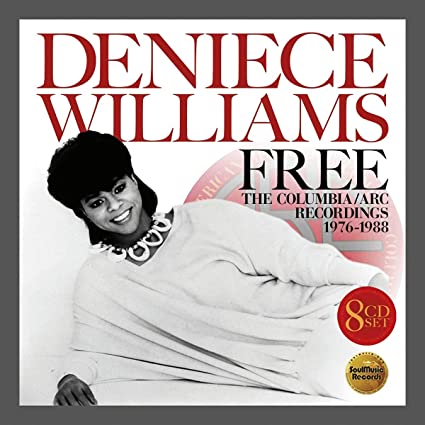Denice Williams - Free: The Columbia/ARC Recordings 1977-1988
My hometown of Gary, Indiana has consistently been the birthplace of some supremely talented people. That was never more obvious than in 1984. Michael Jackson’s Thriller was still a chart-topping album two years after its release. Trail blazing gymnast Dianne Durham reached the finals of the 1984 Olympic trials after becoming the first Black gymnast to win the US National Championship in 1983 and was favored to lead the team to the ’84 Olympics before injuries dashed that dream. Singer Deniece Williams topped the pop charts with her song “Let’s Hear It For the Boy,” which was all over the radio and was featured in the hit film “Footloose.”
Denice Williams - Free: The Columbia/ARC Recordings 1977-1988
My hometown of Gary, Indiana has consistently been the birthplace of some supremely talented people. That was never more obvious than in 1984. Michael Jackson’s Thriller was still a chart-topping album two years after its release. Trail blazing gymnast Dianne Durham reached the finals of the 1984 Olympic trials after becoming the first Black gymnast to win the US National Championship in 1983 and was favored to lead the team to the ’84 Olympics before injuries dashed that dream. Singer Deniece Williams topped the pop charts with her song “Let’s Hear It For the Boy,” which was all over the radio and was featured in the hit film “Footloose.”
We were proud of all of them, and each of them had relatable aspects to their story that could inspire people living in a city experiencing tough times. However, Williams’ story was arguably the most relatable. As detailed in the liner notes of Deniece Williams Free : The Columbia/ARC Recordings 1976-1988 – a box set of the 11 albums Williams made during her 12 years as a hit maker for Columbia Records – Williams’ story included the kind of real life choices that can turn a dream into a dream delayed or even a dream deferred.
Between the time Williams recorded singles as Deniece Chandler on two Chicago based labels in the late 1960s and early 70s and her breakthrough 1976 album This Is Niecy, Williams went to college, started a family, entered the work world, and then toured with Stevie Wonder as a member of Wonderlove, his backing vocalists. So Williams had lived a lifetime of experiences before she caught the ears of Maurice White and Charles Stepney. Once producers such as White, Stepney and George Duke began working with Williams, she would go on to become one of the more consistent hit makers of the 1970s and 80s.
Fans will hear all of Williams’ big hits in this well-made box set. The liner notes go into detail about each song on each of these albums and include quotes from collaborators such as the great Johnny Mathis, who performed with Williams on the 1978 album That’s What Friends are For, which gave Williams her first big crossover hit with “Two Much Too Little Too Late.”
The box set will remind listeners of the ease in which Williams handled the ballads like her “Free” from her debut This is Niecy and “Silly” from the excellent My Melody album, and how that was matched by the energy that Williams put into un-tempo tunes like “Let’s Hear It For the Boy,” “Baby Baby, My Love’s All for You” and “I’ve Got the Last Dance.” Williams’ albums were well rounded and always featured gospel or inspirational songs, such as “Believe In Miracles” from Niecy. That album also included another Williams signature, a version of the Royalettes “It’s Gonna Take A Miracle,” a cut that has gone on to be one Williams’ biggest and best loved hits.
Deniece Williams Free will also reacquaint or acquaint fans and newcomers to some of the lesser known gems that Williams sang -- and in many cases had a hand in writing. “The Paper,” a riveting cut found on Williams second album Song Bird, is a track that captures Williams’ virtues as a songwriter and vocalist. The track of tells the story of the flood of emotions that overwhelm a person preparing to sign their divorce papers, something Williams herself had experienced around this time.
Williams was an adult who had experienced many of life’s highs and lows by the time she hit it big, and those experiences often found their way into her songs, whether she was describing an intimate night with someone you want to be more than a friend in “That’s What Friends are For,” the painful self-awareness that you are being played in “Silly,” or the realization that a relationship is officially over, which is the case with “The Paper.”
This compilation shows that Williams is one of the more underappreciated artists of that era, and that it is time to take a fresh look at the depth and brilliance of her work. Recommended.
By Howard Dukes

